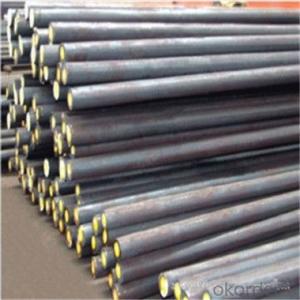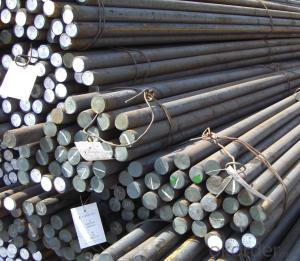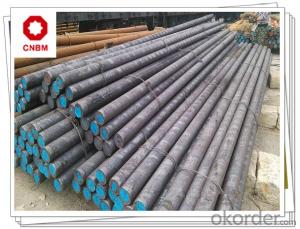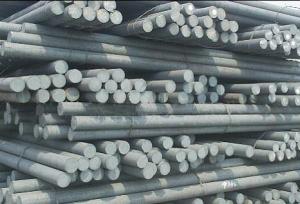Prime Hot Rolled Carbon Steel Round Bar C30
- Loading Port:
- China main port
- Payment Terms:
- TT OR LC
- Min Order Qty:
- 5 m.t.
- Supply Capability:
- 100000 m.t./month
OKorder Service Pledge
OKorder Financial Service
You Might Also Like
Specification
Prime Hot Rolled Carbon Steel Round Bar C30
| Grade | C(%) | Mn(%) | S(%) | P(%) | Si(%) |
| Q235 | ≤0.20 | ≤0.70 | ≤0.045 | ≤0.045 | ≤0.30 |
| Q275 | ≤0.38 | 0.5-0.8 | ≤0.045 | ≤0.045 | ≤0.35 |
| Q345 | ≤0.20 | ≤1.60 | ≤0.045 | ≤0.045 | ≤0.55 |
| SS400 | - | ≤0.05 | ≤0.05 | ||
| S235JR | ≤0.17 | ≤1.40 | ≤0.03 | ≤0.03 |
Product Discription
| Product name | Hot rollde round steel bar |
| Standard | GB/JIS/ASTM/DIN/EN |
| Grade | Q235,Q275,Q345,SS400,SS540,A36,ST37-2,S235JR,S355JR |
| Diameter | 10-80mm |
| MOQ | 10 Metric Ton,also depending on production schedule |
| Delivery Time | 20-40 Days |
| Packing | Standard export packing or as you required |
| Payment term | T/T, L/C |
| Application | construction |
Theoretical Weight (kg/m)
Type | Diameter (mm) | Weight (kg/m) | Available Length | Type | Diameter (mm) | Weight (kg/m) | Available Length |
8Φ | 8 | 0.395 | 6-9m | 38Φ | 38 | 8.900 | 6-9m |
10Φ | 10 | 0.617 | 6-9m | 40Φ | 40 | 9.870 | 6-9m |
12Φ | 12 | 0.888 | 6-9m | 42Φ | 42 | 10.87 | 6-9m |
14Φ | 14 | 1.210 | 6-9m | 45Φ | 45 | 12.48 | 6-9m |
16Φ | 16 | 1.580 | 6-9m | 50Φ | 50 | 15.42 | 6-9m |
18Φ | 18 | 2.000 | 6-9m | 55Φ | 55 | 18.60 | 6-9m |
20Φ | 20 | 2.470 | 6-9m | 60Φ | 60 | 22.20 | 6-9m |
22Φ | 22 | 2.980 | 6-9m | 65Φ | 65 | 26.00 | 6-9m |
24Φ | 24 | 3.550 | 6-9m | 70Φ | 70 | 30.20 | 6-9m |
25Φ | 25 | 3.850 | 6-9m | 75Φ | 75 | 34.70 | 6-9m |
28Φ | 28 | 4.830 | 6-9m | 80Φ | 80 | 39.50 | 6-9m |
30Φ | 30 | 5.550 | 6-9m | 85Φ | 85 | 44.50 | 6-9m |
32Φ | 32 | 6.310 | 6-9m | 90Φ | 90 | 49.90 | 6-9m |
35Φ | 35 | 7.550 | 6-9m |
Products




- Q: What are the advantages of using bearing steel round bars?
- There are several advantages of using bearing steel round bars: 1. High strength and durability: Bearing steel round bars are known for their exceptional strength and durability. They are specifically designed to withstand heavy loads and high impact forces, making them ideal for applications that require a reliable and robust material. 2. Excellent wear resistance: Bearing steel round bars have excellent wear resistance properties, which means they can endure constant friction and abrasion without experiencing excessive wear and tear. This makes them suitable for applications where the material needs to withstand repetitive rotational motion or sliding. 3. Superior hardness: Bearing steel round bars are typically heat-treated to achieve optimal hardness levels. This hardness allows them to maintain their shape and structural integrity even under extreme conditions, such as high temperatures or heavy loads. 4. Dimensional stability: Bearing steel round bars exhibit excellent dimensional stability, meaning they maintain their shape and size even under varying temperature and environmental conditions. This quality is crucial in applications where precise dimensions are required to ensure proper functioning and performance. 5. Corrosion resistance: Bearing steel round bars are often alloyed with elements like chromium and molybdenum, which enhance their corrosion resistance. This makes them suitable for use in corrosive environments, such as marine or chemical industries. 6. Machinability: Bearing steel round bars are relatively easy to machine and process, which allows for efficient production and customization. This makes them a cost-effective choice for various applications, as they can be easily shaped, cut, or drilled according to specific requirements. Overall, the advantages of using bearing steel round bars include their high strength, excellent wear resistance, superior hardness, dimensional stability, corrosion resistance, and machinability. These qualities make them a preferred choice in industries such as automotive, aerospace, machinery, and construction, where reliability, durability, and performance are crucial.
- Q: What are the different grades of steel used in round bars?
- Round bars are made from various grades of steel, each possessing its own distinct properties and applications. Some commonly utilized grades are as follows: 1. Grade 1018 - Mild Steel: This steel has low carbon content, enabling easy machinability and weldability. It finds extensive use in general engineering fields, such as construction, automotive, and machinery. 2. Grade 1045 - Carbon Steel: Known for its medium carbon composition, this steel exhibits high tensile strength and excellent wear resistance. It is commonly employed in applications involving shafts, axles, gears, and other high-stress components. 3. Grades 4140 and 4340 - Alloy Steel: Alloy steels incorporate additional elements like chromium, molybdenum, or nickel to enhance their mechanical properties. These grades offer exceptional strength, toughness, and wear resistance. They are frequently employed in applications that demand high durability and strength, such as automotive parts, aircraft components, and industrial machinery. 4. Grades 304 and 316 - Stainless Steel: Stainless steel is a corrosion-resistant alloy containing a minimum of 10.5% chromium. It finds wide usage in industries such as food processing, chemicals, and medicine due to its remarkable resistance to corrosion, heat, and its appealing aesthetic. 5. Grades A2 and D2 - Tool Steel: Tool steels are designed specifically to possess high hardness, wear resistance, and toughness. They are commonly employed in the manufacture of cutting tools, dies, and molds. These examples represent just a fraction of the diverse range of steel grades used in round bars. The selection of the appropriate grade depends on specific requirements for the application, including strength, corrosion resistance, heat resistance, and machinability.
- Q: Can steel round bars be customized or fabricated?
- Indeed, customization or fabrication of steel round bars is possible to meet specific requirements. Various industries such as construction, manufacturing, and engineering commonly employ steel round bars. These bars can be customized in terms of diameter, length, surface finish, and even material composition. Diverse processes can be used for the customization of steel round bars. For instance, techniques like sawing or shearing can be utilized to cut the bars to the desired length. Heat and mechanical force can also be employed to bend or shape the bars, achieving specific angles or curves. Moreover, processes such as grinding, polishing, or coating can be applied to alter the surface finish of the bars. Moreover, fabrication of steel round bars can include the incorporation of additional features or components. For example, holes or slots can be drilled or machined into the bars to accommodate other parts or fasteners. Threading or grooving can also be implemented to facilitate easy assembly or connection with other components. In conclusion, steel round bars offer flexibility and versatility in meeting different requirements across industries. They can be customized or fabricated in various ways, whether it involves modifying dimensions, shape, surface finish, or incorporating additional features.
- Q: What are the common sizes of steel round bars?
- The specific application and industry standards determine the varying common sizes of steel round bars. Depending on these factors, the sizes can range from 1/4 inch to 24 inches in diameter. The availability of these sizes is often in increments of 1/8 inch or 1/4 inch. It is worth noting that the sizes may differ based on the country or region. Moreover, metric sizes are also an option, with diameters generally ranging from 6mm to 600mm. The extensive selection of steel round bar sizes enables a wide range of applications across different industries.
- Q: Are steel round bars suitable for bridge construction applications?
- Steel round bars are widely utilized in the construction of bridges. They possess numerous benefits for this purpose, such as their remarkable strength, durability, and versatility. These bars have the ability to withstand heavy loads and provide the essential structural support required for bridges. Furthermore, their fabrication and welding processes are easily manageable, resulting in efficient construction procedures. Incorporating steel round bars into bridge construction ensures the resistance of bridges to corrosion, a crucial aspect in environments exposed to moisture or severe weather conditions. Overall, steel round bars are an ideal and frequently employed material in bridge construction due to their strength, durability, versatility, and corrosion resistance.
- Q: How are steel round bars used in the automotive industry?
- Due to their strength, durability, and versatility, steel round bars are commonly employed in the automotive industry for a range of purposes. The production of crankshafts is one of the primary uses of steel round bars in this industry. Crankshafts are essential in converting the reciprocating motion of pistons into rotational motion, which powers the vehicle. Steel round bars are highly suitable for this function due to their high tensile strength, exceptional fatigue resistance, and ability to endure high torque loads. Steel round bars are also utilized in the manufacture of axles. Axles play a critical role in transferring power from the engine to the wheels while supporting the vehicle's weight and ensuring stability. Steel round bars provide the necessary strength and rigidity to handle the substantial loads and forces experienced by axles. Furthermore, steel round bars are employed in the production of suspension components like tie rods and sway bars. Tie rods are crucial for steering and maintaining proper alignment, while sway bars help control body roll and enhance handling. Steel round bars are preferred for these applications due to their exceptional torsional strength, enabling them to withstand the forces and stresses encountered during steering and suspension movements. Moreover, steel round bars are used in the creation of transmission shafts. Transmission shafts are responsible for transmitting power from the engine to the wheels through the gearbox. Steel round bars are well-suited for this task due to their high strength, resistance to bending, and ability to handle the rotational forces and torque generated by the engine. In conclusion, steel round bars are extensively employed in the automotive industry for various applications including crankshafts, axles, suspension components, and transmission shafts. Their superior strength, durability, and versatility make them an ideal choice for these critical components, ensuring the safety, performance, and reliability of vehicles.
- Q: How do steel round bars perform in low-temperature environments?
- Steel round bars generally perform well in low-temperature environments. The mechanical properties of steel, such as strength and toughness, are typically maintained at low temperatures. However, it is important to consider the specific grade of steel being used, as some grades may exhibit reduced impact resistance or brittleness at extremely low temperatures. One common concern is the potential for brittle fracture in steel round bars at low temperatures. This can occur when the steel transitions from a ductile to a brittle state. However, most standard steel grades used in construction and industry are designed to resist brittle fracture even in low-temperature environments. Certain special alloy steels, such as low-temperature carbon steels, are specifically formulated to provide superior performance in extremely cold conditions. These steels contain additional elements, such as nickel or manganese, which enhance their low-temperature properties. They are often used in applications that require excellent toughness and impact resistance, such as offshore structures or cryogenic storage tanks. In summary, steel round bars generally perform well in low-temperature environments, and their mechanical properties are typically maintained. However, it is important to select the appropriate steel grade for the specific low-temperature application to ensure optimal performance and prevent potential issues such as brittle fracture.
- Q: What are the advantages of using copper-alloy steel round bars?
- There are several advantages of using copper-alloy steel round bars in various applications. Firstly, copper-alloy steel round bars offer excellent corrosion resistance. The presence of copper in the alloy helps to protect the steel from rust and corrosion, making it suitable for use in environments with high levels of moisture or chemicals. This corrosion resistance extends the lifespan of the round bars, reducing the need for frequent replacements and maintenance. Secondly, copper-alloy steel round bars have high thermal and electrical conductivity. The copper content in the alloy enhances these properties, making them ideal for applications that require efficient heat transfer or electrical conductivity. This makes them suitable for use in electrical components, heat exchangers, and other similar applications. Another advantage of copper-alloy steel round bars is their superior machinability. Copper has excellent machinability properties, which allows for easy cutting, drilling, and shaping of the round bars. This makes them easier to work with and reduces machining time and costs. Additionally, copper-alloy steel round bars offer good strength and toughness. The steel component in the alloy provides the necessary strength to withstand heavy loads and impacts, while the copper component enhances the toughness, making them resistant to cracking or breaking under stress. This makes them suitable for use in structural applications, where high strength and durability are required. Furthermore, copper-alloy steel round bars exhibit good thermal stability. They can withstand high temperatures without losing their mechanical properties, making them suitable for applications that involve exposure to extreme heat or thermal cycling. In conclusion, the advantages of using copper-alloy steel round bars include excellent corrosion resistance, high thermal and electrical conductivity, superior machinability, good strength and toughness, and high thermal stability. These properties make them a preferred choice in various industries, including construction, electrical, automotive, and manufacturing.
- Q: How are steel round bars used in the manufacturing of hydraulic systems?
- Steel round bars are commonly used in the manufacturing of hydraulic systems due to their strength, durability, and versatility. These bars serve various purposes in the construction and assembly of hydraulic components. One primary use of steel round bars in hydraulic systems is for the fabrication of piston rods. Piston rods are crucial components of hydraulic cylinders, responsible for transferring the force generated by the hydraulic fluid to the desired mechanism. The high strength and rigidity of steel round bars make them ideal for this application, as they can withstand the intense pressure and stress exerted on the piston rod during operation. Steel round bars are also utilized in the manufacturing of shafts and axles within hydraulic systems. These components are responsible for transmitting rotational motion and torque from the hydraulic pump to other mechanical parts, such as gears or pulleys. By using steel round bars, manufacturers can ensure the reliability and longevity of these critical parts, as they possess excellent mechanical properties and resistance to wear and tear. Additionally, steel round bars are often employed in the construction of hydraulic fittings and connectors. These components are responsible for joining different hydraulic pipes, hoses, or valves together, creating a sealed system for fluid transmission. Steel round bars provide the necessary strength and stability to withstand the high-pressure conditions within hydraulic systems, ensuring leak-free operation and the efficient transfer of fluids. In summary, steel round bars play a vital role in the manufacturing of hydraulic systems by providing strength, durability, and versatility. Their use in piston rods, shafts, axles, fittings, and connectors ensures the proper functioning and reliability of these systems.
- Q: Can steel round bars be used in the food processing industry?
- Steel round bars can indeed be utilized in the food processing sector. Steel is widely applied across various industries owing to its robustness, longevity, and ability to resist corrosion. In the realm of food processing, steel round bars find frequent application in equipment like food mixers, conveyors, and cutting tools. These bars are typically crafted from stainless steel, a specific steel variant enriched with chromium and other elements to enhance its resistance against corrosion and staining. Remarkably, stainless steel is non-reactive and does not introduce any flavors or odors into the processed food. Additionally, it is effortless to clean and maintain, rendering it highly suitable for deployment in food processing facilities where hygiene is paramount. However, it is crucial to ensure that the steel round bars employed in the food processing industry adhere to the necessary standards and regulations to guarantee the safety of the processed food.
Send your message to us
Prime Hot Rolled Carbon Steel Round Bar C30
- Loading Port:
- China main port
- Payment Terms:
- TT OR LC
- Min Order Qty:
- 5 m.t.
- Supply Capability:
- 100000 m.t./month
OKorder Service Pledge
OKorder Financial Service
Similar products
Hot products
Hot Searches
Related keywords


































